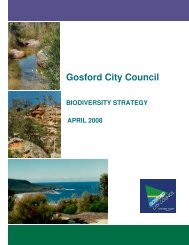Cockrone Lagoon Aquatic Biological Survey-Final Report (PDF File ...
Cockrone Lagoon Aquatic Biological Survey-Final Report (PDF File ...
Cockrone Lagoon Aquatic Biological Survey-Final Report (PDF File ...
You also want an ePaper? Increase the reach of your titles
YUMPU automatically turns print PDFs into web optimized ePapers that Google loves.
Australian <strong>Aquatic</strong> <strong>Biological</strong> Pty Ltd<br />
5. Results and Discussion<br />
Please note that results listed here reect the species at that site at that time. Over time during<br />
different conditions different species or numbers may be present.<br />
5.1. Crustaceans<br />
5.1.1. Freshwater Craysh.<br />
Prior to this research project only Euastacus australasiensis and Euastacus spinifer were recorded<br />
from the Gosford LGA, neither was known to occur within the <strong>Cockrone</strong> <strong>Lagoon</strong> catchment<br />
and these two species were specically searched for. Additionally, coastal habitats in NSW are<br />
known to contain two undescribed species of freshwater craysh of genus Tenuibranchiurus and<br />
Gramastacus and these were also targeted.<br />
<strong>Survey</strong> No.:100056-1 of Wamberal <strong>Lagoon</strong> identied two species of craysh in that catchment,<br />
an endemic species Gramastacus sp and an invasive introduced species Cherax destructor. Both<br />
these species were specically searched for in the <strong>Cockrone</strong> <strong>Lagoon</strong>, Winney Bay and Copacabana<br />
catchments.<br />
Both Wyong LGA to the north and Gosford LGA to the south represent a signicant freshwater<br />
craysh distribution area. Though the knowledge base is small there seems to be a cut off line<br />
roughly running from Wamberal <strong>Lagoon</strong>, through Narara and then up through Central Mangrove<br />
that represents a species distribution line with one species (Euastacus spinifer) occurring on both<br />
sides, two species (Cherax setosus and Gramastacus sp) only north of the line and one species<br />
(Euastacus australasiensis) only south of the line. This project will map that line and the distribution<br />
of these craysh species along the line, and the surrounding region. A scientic manuscript on<br />
those ndings is proposed.<br />
No craysh species at all were found within the <strong>Cockrone</strong> <strong>Lagoon</strong>, Winney Bay and Copacabana<br />
Catchments.<br />
5.1.2. Euastacus Craysh<br />
We were unable to conrm the presence of either E. spinifer or E. australasiensis. It would be our<br />
conclusion that the area is unsuitable for both species as the tributary creek system is too small<br />
and without sufcient highland catchment to support the clean, clear permanently owing creek<br />
systems preferred by these species.<br />
5.1.3. Gramastacus Craysh<br />
No craysh have been collected within any of the catchment areas surveyed. Suitable habitat areas<br />
were found but too small to sustain viable populations.<br />
5.1.4. Cherax<br />
Yabbies Cherax destructor were not<br />
found within the catchment. This was<br />
a good sign and it is hoped that better<br />
education will keep them out. Their vivid<br />
colours make them popular aquarium pets<br />
but unfortunately uneducated or uncaring<br />
people release them into the wild creating<br />
major environmental problems.<br />
Figure 4. An aquarium blue yabby<br />
<strong>Cockrone</strong> <strong>Lagoon</strong> Catchment <strong>Aquatic</strong> Biodiversity <strong>Report</strong> 13

















